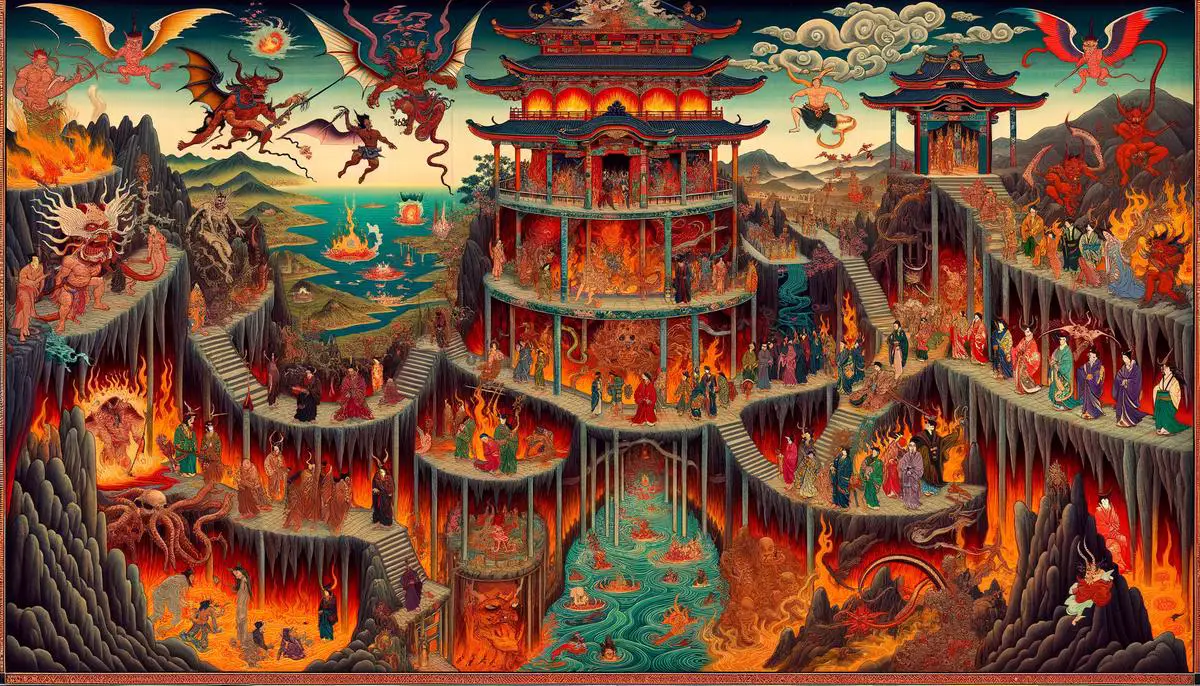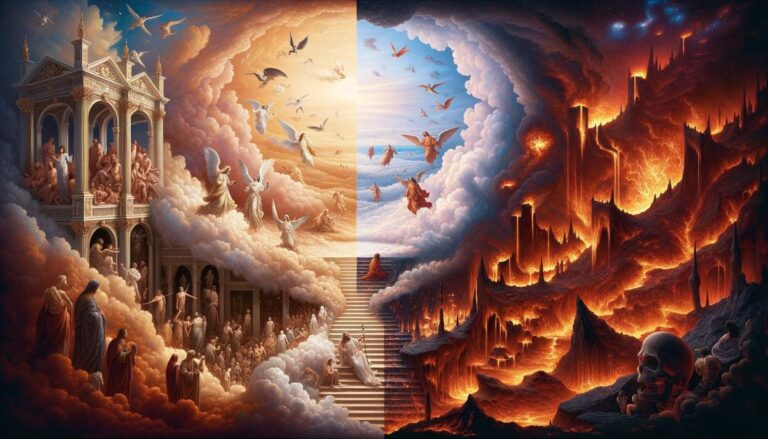Historical Context
Throughout art history, heaven and hell have captured the imagination of artists, each era bringing its own interpretation to these eternal domains. In medieval times, art was deeply rooted in Christian doctrine, illustrating heaven as a luminous, orderly place filled with saints and angels, often portrayed sitting in ranks or singing praises around the throne of God. Hell, on the other hand, was depicted as a chaotic realm, with fiery pits and grotesque demons tormenting sinners in ways that served as moral lessons.
During the Renaissance, artists began to explore these themes with more depth and individuality, influenced by humanism and a renewed interest in classical antiquity. Michelangelo's "The Last Judgment" in the Sistine Chapel reveals a dynamic heaven, teeming with motion and emotion as the saved ascend. Hell, depicted in the same piece, is a tumultuous netherworld where sinners face their ultimate fate, showcasing the artist's skill in conveying human suffering and divine wrath.
In the Baroque period, artists like Peter Paul Rubens injected their canvases with a heightened sense of drama and energy. His "The Fall of the Damned" captures the tumult of damnation with vivid emotion.
Modern representations of heaven and hell reflect the changing perspectives and existential questions of the eras. Romantic artists like William Blake ventured into complex, symbolic portrayals, influenced by mystical visions and a deep interest in the spiritual. His illustrations for "The Divine Comedy" reimagined Dante's intricate afterlife with vivid imagination.
In the 20th century and beyond, artists like Salvador Dali brought surrealism into the exploration of these realms, disrupting conventional narratives with dream-like landscapes filled with symbolic objects. His work embodies the modern psyche's attempts to reconcile ancient spiritual concepts with contemporary realities.
The evolving depictions of heaven and hell mirror humanity's eternal search for meaning and understanding beyond this life. The artistic journey through these metaphysical landscapes reveals much about our deepest fears and highest hopes, shaped by the cultural, philosophical, and technological shifts of each period.
Iconic Works
"The Garden of Earthly Delights" by Hieronymus Bosch
Bosch's triptych, "The Garden of Earthly Delights," remains a powerful enigma, replete with symbolic and cautionary tales. The left panel depicts a heavenly paradise, teeming with life and purity. The right panel is a nightmarish vision of hell where sinners endure bizarre and torturous consequences. Central to this painting is the earthly paradise gone awry, serving as an allegory for moral decay. Bosch's work engages audiences in a complex dialogue about human morality and divine justice.
"The Last Judgment" by Michelangelo
Michelangelo's monumental fresco "The Last Judgment," spanning the altar wall of the Sistine Chapel, captivates with its dramatic depiction of heaven and hell. It illustrates the Second Coming of Christ and the final judgment of all souls. The stark contrast between the saved, ascending to heaven, and the damned, dragged to hell by demons, underscores the theme of divine retribution. Michelangelo's use of human anatomy to convey emotion reflects Renaissance humanism and constitutes a profound statement on the human condition.
"The Fall of the Rebel Angels" by Pieter Bruegel the Elder
Bruegel's 1562 painting "The Fall of the Rebel Angels" is a vivid portrayal of Archangel Michael and his army expelling the rebel angels from heaven, transforming them into grotesque demons as they fall to hell. Bruegel incorporates elements of Northern Renaissance art, such as meticulous detail and a moralizing vision, turning biblical narrative into a reflection on human folly.
"A Vision of Hell" by William Blake
In this work, Blake presents hell not merely as a physical space but as a tempestuous state of being. "A Vision of Hell" showcases Blake's unique style of combining poetry with visual arts, unfolding a terrifying yet deeply symbolic interpretation of damnation. Unlike traditional views, Blake's hell is both a punitive environment and a manifestation of internal torment, resonating with the Romantic era's exploration of emotion, individualism, and the darker aspects of the psyche.
These paintings—spanning centuries and artistic eras—underscore the enduring fascination artists have held for heaven and hell. They reveal the changing aesthetics and ideologies concerning the afterlife and invite us to contemplate humanity's perennial concerns about virtue, vice, salvation, and punishment.

Artistic Interpretation
Influence of Artists' Backgrounds on Depictions of Heaven and Hell
The realms of heaven and hell, as depicted by artists throughout history, are intimate portrayals shaped by the artists' backgrounds, cultures, and personal beliefs. These influences imbue each work with a unique perspective, allowing us to better understand not just the artist's vision but the broader cultural and historical context in which they were created.
Personal Beliefs and Experiences
The personal beliefs and life experiences of artists often have a profound influence on their interpretations of heaven and hell. William Blake's spiritual views, for example, were deeply personal and radically nonconformist. His works are as much a window into his unique spiritual vision as they are an exploration of the broader themes of redemption and damnation.
Salvador Dali fused his exploration of heaven and hell with a distinctive surrealistic approach influenced by his complex relationship with faith, hailing from Catholic Spain yet engaging with and sometimes rebelling against traditional religious values. Dali's depiction of these metaphysical spaces is intertwined with his explorations of psychoanalysis, showcasing a layered vision where personal and cultural symbols converge.
Cultural and Geographical Context
The cultural and geographical context of artists also significantly shapes their depiction of heaven and hell. Hieronymus Bosch, working in the Late Middle Ages in Northern Europe, was influenced by the region's religious fervor and the prevalent iconography of the time. His "Garden of Earthly Delights" echoes Northern European concerns about sin and morality.
In contrast, the vibrant depictions of hell in Japanese art, such as those found in the "Scrolls of the Judges of Hell," reflect Buddhism and Shintoist influences unique to Japan's cultural landscape. These works detail a hierarchical and systematic vision of hell influenced by Buddhist texts, demonstrating how deeply rooted cultural narratives shape artists' conceptions of the afterlife.
Era and Religious Climate
The era in which artists created their works greatly influenced their depictions of heaven and hell, shaped by the religious and philosophical climate of their times. During the Renaissance, there was a revival of interest in humanism alongside continued devotion to Christian teachings. Michelangelo's "The Last Judgment" reflects this duality by merging Classical ideals of beauty and form with the Christian narrative of salvation and damnation.
Similarly, in periods of social upheaval or existential questioning—such as the modernist era—artists like Paul Klee explored heaven and hell through abstract depictions that veer away from traditional imagistic representations. Klee's works reflect a modern angst and search for meaning within a rapidly changing world, highlighting how shifts in philosophical outlooks across different eras play into artists' renderings of these eternal themes.
The various backgrounds of artists—their personal beliefs, cultural identities, and the era they lived in—profoundly shape their depictions of heaven and hell. These paintings, sculptures, and illustrations serve as cultural artifacts that hold within them the fears, hopes, and immense creativity of humankind's quest to understand the afterlife.

Symbolism and Themes
Symbolism and Themes in Artistic Depictions of Heaven and Hell
In the vast tapestry of art history, the visualization of heaven and hell uses a rich palette of symbols and themes to communicate profound moral, philosophical, and theological ideas. These representations, as diverse as the artists behind them, still canvas a commonality of symbols and motifs that cut across cultures and epochs, serving both as a universal language and a mirror reflecting the varied understandings of the afterlife.
Light vs. Darkness
The contrast between light and darkness serves as a recurring symbol to differentiate heaven from hell. Light, often golden and radiant, signifies divine presence, purity, and enlightenment—qualities associated with heaven. In contrast, darkness envelops depictions of hell, embodying absence, torment, and ignorance. This symbolic use of light not only demarcates the realms but also offers commentary on moral and spiritual conditions.
Landscape as Destiny
The landscapes of heaven and hell often carry symbolic meaning, articulating the fate awaiting souls in each realm. Heaven is portrayed as an ethereal, often idyllic place—gardens, celestial cities, and serene fields populated by angels and the righteous. Hell's landscapes, however, are tumultuous and inhospitable: fiery pits, desolate wastelands, and dizzying chasms. Such landscapes articulate themes of chaos, suffering, and banishment from divine grace.
Architectural Majesty vs. Ruins
In artistic depictions, architecture often takes on symbolic overtones. The heavenly realm is marked by perfect, often grandiose architecture—immaculate palaces, temples, and cities reaching towards infinity. Conversely, hell is depicted with crumbling ruins, twisted structures, and prisons that imprison its inhabitants. This juxtaposition reinforces themes of order versus chaos, stability versus disintegration.
The Mirror of Sins
A recurring theme in representations of hell is the depiction of punishments that mirror the sins committed in life. Such visual motifs serve as warnings to the viewer. Gluttons might be devoured repeatedly; the avaricious might be crushed under boulders of gold—a literal interpretation of being burdened by one's greed. These thematic mirrors reflect the moral codes of the societies producing these artworks and explore the concept of divine justice.
The Passage of Souls
The journey or passage of souls is a motif that unites many depictions of heaven and hell. The crossing of a river or bridge often represents the transition from life to afterlife, reflecting ancient beliefs seen across multiple cultures. The visual iteration of this journey encompasses themes of redemption, transformation, and the irrevocability of death's passage.
Angels and Demons: Agents of Cosmic Order
Angels and demons populate these realms as symbols of cosmic order and disorder. Angels are messengers and warriors, epitomizing obedience to divine will and protection of the righteous. Demons, in contrast, symbolize rebellion, corrosion of order, and the predation of souls—the embodiment of chaos opposed to cosmic harmony.
Artistic depictions of heaven and hell are far more than mere speculations on the afterlife. They function as moral compasses, philosophical inquiries, and theological explorations—each brushstroke weaving together universal questions about human existence, morality, and the ultimate nature of reality itself.

The artistic journey through the depictions of heaven and hell is a mirror to humanity's unending quest for meaning, morality, and understanding of the afterlife. Through the ages, artists have wielded their brushes to engage in a deeper exploration of human virtues and vices. This enduring fascination and continuous reinterpretation underscores our collective endeavor to comprehend what lies beyond the veil of this life.
- Marmor MF, Ravin JG. The Artist's Eyes: Vision and the History of Art. New York: Abrams; 2009.
- Quílez i Corella FM. Heaven, Hell, and Dying Well: Images of Death in the Middle Ages. Los Angeles: J. Paul Getty Museum; 2012.
- Turner JG. The Iconology of Heaven and Hell in Western Art. Florilegium. 1986;8:115-137.
- Werness HB. The Continuum Encyclopedia of Animal Symbolism in Art. New York: Continuum; 2006.

